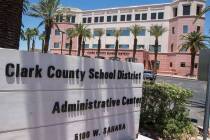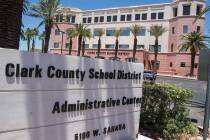Teaching the teachers: Orientation prepares new hires




The biggest mistake that Doug Ratcliffe made was becoming a banker.
It took him 15 years to realize, coming to the conclusion only after being laid off as a bank manager. But from the anxiety of unemployment came an epiphany for the father of four. He didn’t want another job but another career – his first choice.
“A year later, here I am,” he said Thursday, smiling as he stood outside a Venetian ballroom packed with 1,782 others entering their second professions or starting their first. A little less than half came from in state but most moved to Nevada, coming from as far as New York. And they’re all here for the same reason.
Come Aug. 26, they’ll be standing at the front of classrooms in the nation’s fifth-largest school system – Clark County School District – expecting 312,000 students. New teachers spent two days at the Strip hotel for necessary training.
Not since 2005 has the district hired so many new teachers for a school year, but 1,300 departing teachers needed to be replaced, 700 teachers are being added to decrease class sizes, and 100 other Clark County teachers were funded by the state’s $50 million expansion to programs for English-learning students.
“This is so many teachers. Hard to fathom until now,” said Laura Labovitz, who was substitute teaching between earning her master’s degree in history from the University of Nevada, Las Vegas, and starting her doctorate. But she had a change of heart.
The district still needs to hire about 170 teachers – mostly in elementary schools and special education – to fill the needs of its 357 schools, said Staci Vesneske, chief human capital officer. Come the first day of school, the district’s army of 18,000 teachers could fill the seats of UNLV’s Thomas and Mack Center.
This newest batch all have their own stories and reasons for taking a job in the large but academically struggling district, which posted a 61 percent graduation rate in 2012, according to the Nevada Department of Education’s most recent statistics.
Ratcliffe will be at Sunrise Mountain High School, one of the district’s worst performing campuses beginning its radical turnaround this year. New principal, some new staff. Sunrise, near Hollywood Boulevard and Carey Avenue, reported a 37 percent graduation rate in 2012.
Ratcliffe will be teaching English to freshmen, sophomores and juniors. He’ll have a challenge. Only a third of Sunrise’s sophomores pass the state reading test required to graduate.
But Ratcliffe chose the challenge. After interviews with other principals, he bought into the plan of Sunrise’s new leader.
“I’ll be driving 40 minutes one way to get to my school, driving past four others,” he said, acknowledging the nerves of a new job. “But I’ve always wanted to be a teacher.”
Ratcliffe’s first college major was education. However, he abandoned it for the more lucrative field of business, which he stayed in for 15 years. “But money is not the be-all and end-all. I’d rather be happy.”
Both he and Labovitz took the district’s Alternative Route to Licensure program enabling those with non-education bachelor’s degrees to become teachers after some intensive coursework and training. About 42 percent of the district’s new teachers are just that, new, like Ratcliffe perhaps with some experience as substitutes but never as full-time teachers. They will be teaching an average of 35 students per classroom in middle and high schools, which is a three-student improvement over the district’s average in 2012-13, but still daunting.
Susan Bankosz, formerly an accountant, already got a glimpse of what’s to come, teaching summer school Algebra I to a class of 47 students. Her other class had 39 students.
“I’m terrified of classroom management,” said the incoming Valley High School teacher, recalling the headache of trying to get all her students to stop talking, put their cellphones away or take their earphones out.
But only one of her summer students failed the math course that they were retaking.
“I was amazed,” Bankosz said.
Contact reporter Trevon Milliard at tmilliard@reviewjournal.com or 702-383-0279.


















